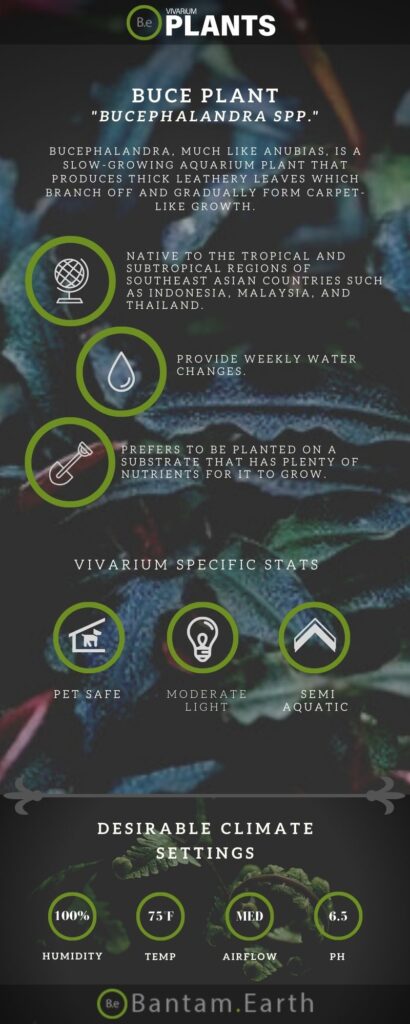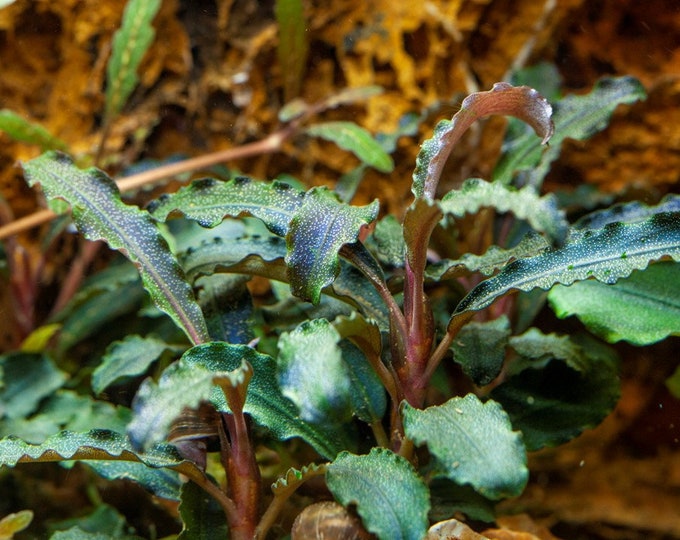Do you want a lush, vibrant vivarium without needing to spend hours tending to it?
Bucephalandra spp., more commonly called Buce Plant, is a perfect addition to any aquarium.
Buce Plant is a low-maintenance, slow-growing aquatic plant that is easy to propagate and is perfect for beginning hobbyists.
Not only can Buce Plant be used to create beautiful foreground accents, but it can also help reduce algae growth in an enclosure, making it a beneficial and stylish addition.
This article explores the various features that make Buce Plant a must-have for any enclosure.
| Quick Stats: | |
|---|---|
| Scientific Name | Bucephalandra spp. |
| Common Name | Buce Plant, Buce |
| Family Name | Araceae |
| Habitat | Tropical Shallow Water |
| Temperature | 70°F to 82°F |
| Height | 4 to 8 inches |
| pH | 5.5 to 7.0 |
| Lighting | Moderate to High |
Table Of Contents:
ToggleWhat is a Buce Plant?
Bucephalandra is a genus of anubias-like plants which are native to the island of Borneo as well as a few other Southeast Asian islands.
This genus can have a variety of colors and unique shapes making it a top pick for hobbyists.
Many of the species are desired for their broad leaves, thick branching structures, and fragility to moonlighting.


Buce Plant Facts
Bucephalandra comes in a wide array of different colors and sizes.
There are over 20 different species of Buce which makes it a unique plant to find in a setup.
Many of these species are small enough that they can be used as accent plants in nano tanks as well as larger aquariums and paludariums.
Description
Bucephalandra, much like Anubias, is a slow-growing aquarium plant that produces thick leathery leaves which branch off and gradually form carpet-like growth.
The plants are typically solid green but new varieties are often coming out that have different colors and patterns.
The underside of the leaves will have distinct color-changing qualities which tend to go more red and pink when exposed to lower lighting levels.
Habitat
Bucephalandra spp. is native to the tropical and subtropical regions of Southeast Asian countries such as Indonesia, Malaysia, and Thailand.
It grows in marsh and shallow waters close to the surface and is often found in limestone crevices.
pH Preference
Although Bucephalandra can vary greatly based on species, most prefer a neutral range of 5.5-7.0.
Buce can also tolerate slightly higher pH ranges and with the correct nutrient supply, specimens will thrive more.
Vivarium Type
The Buce Plant is quite an easy-going species.
With that in mind, it will not be too complicated when it comes to choosing the type of enclosure it is grown in.
It is best to try and replicate the plant’s natural habitat as much as possible.
Doing so will make it easier to provide this foliage plant with its basic needs.
The proper setup and theme of the enclosure will make a big difference to the overall look and health of the plant.
Be sure to choose setups that are moist and high in humidity.
Here are recommended vivariums it will do well in:
-
- Paludariums – Half aquatic/ half terrain-based enclosure.
-
- Terrariums – Fully terrain-based enclosures with little to no aquatic features.
-
- Ripariums – Mostly aquatic-based enclosures with some terrain features present.
-
- Aquarium– Fully aquatic-based enclosure with little to no dry terrain.
Vivarium Placement
Bucephalandras are usually placed in the background or midground of any layout, they tend to look better in larger tanks that showcase their unique shape and coloration.
When planting in an aquarium or paludarium, use a light but firm substrate and tie it down with a little weight.
This species will not hold itself down but the weight of the substrate will help the roots manage where the plant grows in the tank.
Substrate
Bucephalandra prefers to be planted on a substrate that has plenty of nutrients for it to grow.
This can be in the form of nutrient-rich soils, gravel, or sand.
The best choice of aquatic substrate would be a gravel or sand-based soil mix as this will also help reduce the pH level in the tank.
Lighting
Bucephalandra can survive in low lighting levels but will reach its full potential in tanks with medium to high light levels.
In larger tanks, using LEDs or other forms of aquatic lighting will give the most optimal growth, but the species will do well in tanks that are naturally lit with sunlight as well.
Buy Buce Plant
When it comes to buying Juncus effusus, there are a few things to keep in mind.
Making sure the plant is healthy when purchased is essential for its success in a vivarium or pond.
Vegetation that is already in poor conditions will have a very hard time adjusting to new environments.
Click the image below to find out more about the current price and other relative info about this plant.
Buce Plant Care and Propagation
Bucephalandra is a very easy plant to care for and propagate.
To propagate, simply cut stems that have several leaves and attach them to some hardscape with thread or fishing line.
New roots will start growing soon afterward.
When caring for Bucephalandra, frequent trimming is necessary to maintain a healthy and lush look.
How to Grow
Bucephalandra spp. is typically a slow grower and its propagation rate depends on the species’ growth habits.
To encourage its growth, ensure that it is planted on a substrate with plenty of nutrients.
Also, keep in mind that the plant likes to be in a location with low to medium flow which will supplement its nutrient supply.
Water Requirements
Bucephalandras are very forgiving and can tolerate both under and over-watering.
To maintain a healthy biomass, keep the tank topped regularly with low-ph water and keep the substrate consistently rich with nutrients.
A properly fertilized setup with weekly water changes should keep this low-maintenance plant in good condition.
Plants Similar to Buce Plant
Adding diversity to an enclosure is key to an aesthetically pleasing setup.
Try mixing up the look of your vivarium with different flora that can easily co-exist in the same types of environment.
Furthermore, if for some reason you find the Buce Plant hard to acquire or would like to consider something similar to this aquarium plant…
Here are other aquatic plants you might find will do well with or in place of Bucephalandra:
Conclusion
In conclusion, Buce Plant offers aquarium hobbyists a wide range of benefits, from easy propagation and low-maintenance requirements to stunning accents and helpful algae reduction.
With its diversity of colors and shapes, Buce Plant is an extremely versatile plant that can be used to create a lush and vibrant enclosure.
If you’re looking for a unique and low-maintenance way to add beauty to your aquarium, Buce Plant is a perfect choice.
Frequently Asked Questions
No, Bucephalandra are actually quite easy to grow in many different water conditions and substrates, making them a great plant for beginning aquarists. Bucephalandra will benefit from regular water changes and occasional trimming to remove dead or damaged leaves.
Yes, Bucephalandra can grow without CO2. It can survive with just the carbon dioxide present in the environment or water column. However, it grows much faster when provided with additional CO2.
Bucephalandra typically grows on wood or rocks submerged in aquariums, though it can also grow without either anchor.
Yes, buce can grow out of water. Buce requires an area with high humidity and warmth to survive and can be grown in a variety of locations such as in soil, on trees, and in vivariums.
A Buce plant, or “bucephalandra“, is a type of hardy, slow–growing, ornamental aquatic plant native to Southeast Asia. The leaves of buce plants can range from dark green to reddish brown and feature intricate, deep veining patterns. They are an ideal choice for aquascaping, as they can easily be trimmed and manipulated to fit a desired aquatic environment. Buce plants are also known to be able to thrive in both low and high tech aquariums.
Attach Buce to rocks with fishing line or thin wire. Make sure to tie it securely and leave enough space between the buce and the rock so that it can reach deeper water or have more space to grow. You can also use glue or suction cups to attach Buce to rocks.
Yes, it is recommended to trim Bucephalandra to keep it healthy and promote growth. Trimming away any dead or overgrown leaves can help rejuvenate the plant, prevent the spread of disease, and encourage new and healthy growth.
Yes, Bucephalandra can bloom. Flowers may appear in clumps along the stem, at the base of the plant, or in the middle of a leaf axil. The flowers are small and inconspicuous, typically in shades of white, yellow, and green.




